- Evaluation of the hydration heat and strength progress of cement–fly ash binary composite
Xiao-Yong Wanga,b*
aDepartment of Architectural Engineering, Kangwon National University, Chuncheon 24341, Korea
bDepartment of Integrated Energy and Infra System, Kangwon National University, Chuncheon 24341, Korea
Fly ash is an industry
by-product of thermal power factories that is broadly utilized in the concrete
industry. This research shows a framework for evaluating the hydration heat,
reaction amount, and strength progress of cement–fly ash binary composite.
First, we conducted an experiment to study the isothermal hydration heat of fly
ash composite paste with assorted fly ash contents and temperatures. According
to the experimental outcomes of cumulative hydration heat, the coefficients of
a kinetic reaction model of fly ash were determined. Furthermore, the reaction
amount of fly ash was calculated using a fly ash reaction model. We discovered
that the reaction of fly ash is considerably improved at elevated temperatures.
The reaction amount of fly ash decreases with the growing content of fly ash.
Second, in line with the reaction amount of fly ash and cement, we developed a
straight-line equation for evaluating the strength progress of binary
composite. The strength progress model applies to a number of water-to-binder
ratios and fly ash substitution ratios. Summarily, the suggested
hydration–heat–strength model is helpful for understanding the material style
of fly ash concrete.
Keywords: Fly ash, Hydration heat, Reaction degree, Strength, Model
Fly ash is really a pozzolanic mineral admixture that is
able to interact with calcium hydroxide to create secondary calcium silicate
hydrate. Fly ash concrete shows several benefits, for example, low hydration
heat and low temperature increase of hardening concrete, good workability, high
long-term strength, and high resistance of chloride ingression.
Evaluations of qualities, for example, hydration heat and
strength development, are useful for the rational usage of
fly ash in construction [1, 2].
Many numerical models have been proposed for binary
composite containing fly ash and cement. Lam et al. measured the amount of
reaction of fly ash using the technique of selective dissolution and evaluated
the progress of strength of binary composite using gel–space ratios [3].
Schindler and Folliard predicted the hydration heat of hardening
concrete with supplementary cementing materials, for example,
slag and fly ash. Furthermore, an overall reaction degree of binders was
proposed in Schindler and Folliard’s study [4]. Based on the experimental
results of calcium hydroxide content, Pane and Hansen analyzed the amount of
reaction of mineral admixtures, for example, slag, fly ash, and silica fume
[5]. Based on isothermal hydration heat, Han et al. analyzed the kinetic
hydration process of fly ash composite paste,
and an overall reaction degree was used for binary composite[6]. Baert
et al. proposed a multi-component model for evaluating the release of hydration
heat of blended paste with various fly ash contents [7]. Nath et al. analyzed
the kinetic reaction of fly ash geopolymer using isothermal
hydration heat and the modified Jander equation [8]. Deschner et
al. proposed thermodynamic modeling for fly ash composite concrete, in which
the phase assemblage of binary composite at various curing temperatures is
evaluated [9]. Xu et al. evaluated the hydration heat and amount of reaction of
binary composite using a three-parameter equation [10].
Narmluk and Nawa proposed a theoretical model of hydration and calculated
the reaction amount of cement in composite paste containing fly ash and cement,
and the improvement of the amount of reaction of cement because of the addition
of fly ash addition was clarified [11]. Garcia-Lodeiro et al. proposed a
descriptive model for the reaction of binary composite containing alkalis [12],
and the effects of different types of alkalis on hydration products were
clarified [12].
Although many modeling investigations have been proposed
for fly ash concrete, these investigations show some
weak points. First, most of the studies focus on single
properties of concrete, such as hydration heat [4, 6-8, 10] or strength
development [3]. To rationally use fly ash, an integrated model for both
hydration heat and strength development will be more helpful for engineering
practices. Second, in previous studies [5, 8, 10], the parameters of the models
are dependent on a specific mix of ratios, such as the water-to-binder ratio
and the fly ash substitution ratio. When the mixtures are changed,
it is difficult to use these models [5, 8, 10]. Third, most
hydration models focus on ordinary-strength or high-strength
concrete [4-7, 9-11], which has a water-to-binder ratio higher than
0.3. Studies on the hydration of cement-based materials that have a much lower
water-to-binder ratio are very limited. On the other hand, ultra-high-performance
concrete that has a very low water-to-binder ratio is increasingly being used
in constructions [13, 14]. Thus, it is necessary for us to propose a new
hydration model that is valid for ultra-high-strength,
high-strength, and ordinary-strength concretes.
To overcome the flaws of previous studies, this research
proposes a framework for evaluating the release of hydration heat, reaction
amount, and strength progress of binary composite. According to the
experimental outcomes of isothermal hydration heat with assorted temperatures,
the reaction amount of fly ash is calculated using a kinetic reaction model. Furthermore,
in line with the reaction amount of fly ash and cement, a straight-line
equation is suggested for evaluating the strength progress of binary composite
with assorted water-to-binder ratio and fly ash-to-binder ratio. The suggested hydration–heat–strength
model is helpful for understanding the material style of fly ash
concrete.
The
cement hydration model
Our previous study showed a model for the kinetic
hydration process of Portland cement [13, 15]. This model takes
into account the kinetic phases of hydration, for example,
the phases of initial dormant, boundary reaction, and diffusion. The degree of
hydration of cement a
can be calculated using a method of integration such as a = ![]() , where da/dt
is the rate of hydration of cement. The model of cement hydration considers
the shortage of capillary water and, consequently, the
insufficient hydration of concrete with a low water-to-binder ratio, such as
high-strength and ultra-high-strength concretes. The input
parameters of the hydration model consist of cement
compositions, concrete mix ratios, and curing circumstances. The output result
of the hydration model is the reaction amount of cement.
, where da/dt
is the rate of hydration of cement. The model of cement hydration considers
the shortage of capillary water and, consequently, the
insufficient hydration of concrete with a low water-to-binder ratio, such as
high-strength and ultra-high-strength concretes. The input
parameters of the hydration model consist of cement
compositions, concrete mix ratios, and curing circumstances. The output result
of the hydration model is the reaction amount of cement.
The
fly ash reaction model
Fly ash is a type of pozzolanic material that can react
with calcium hydroxide and can form secondary calcium silicate hydrate [16].
Compared to cement, the reactivity of fly ash is low. The initial dormant
period of the reaction of fly ash is long. In addition, the kinetic reaction process
of binary composite is similar to that of plain cement [17]. At a late age of
hydration, the control stage of pozzolanic reaction is diffusion
[18]. Considering the material characteristics and reaction
kinetics of fly ash, we assume the reaction of fly ash comprises the phases of
initial dormant, boundary reaction, and diffusion. The kinetic reaction
equation process is shown as follows:
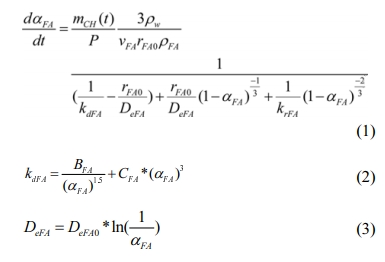
where aFA
denotes the reaction amount of fly ash; mCH(t) and P denote the masses of calcium
hydroxide in hydrating binary composite and fly ash in the concrete,
respectively; nFA
denotes the stoichiometric ratio of fly ash to calcium hydroxide (nFA =
0.845 -0.7(P/(C+P)), where C denotes the mass of
cement in concrete [13]); rFA0 denotes the average
radius of the particles of the fly ash; rFA
and rW
denote the density of the fly ash and water, respectively; kdFA
denotes the reaction rate coefficient of the dormant stage (BFA
and CFA are sub-coefficients); DeFA0
denotes the initial diffusion coefficient of the diffusion stage; and krFA
denotes the reaction rate coefficient of the boundary reaction stage.
For binary composite, calcium hydroxide content is
dependent on both the hydration of cement and the reaction of fly ash. The mass
of calcium hydroxide can be established as follows:

where RCHCE is the
calcium hydroxide production when the unit mass of cement hydrates; a is the hydration degree of cement;
and RCHCE * C * a
and nFA * aFA * P
denote the calcium hydroxide production from the hydration of cement and from
the reaction of fly ash, respectively.
For binary composite, capillary water is consumed by the
reactions of fly ash and cement. The content of capillary water can be
determined as follows:

where Wcap and W
are the masses of the remaining capillary water and mixed water in concrete
mixtures, respectively; and 0.25 * aFA * P
and 0.4 * C * a refer to the masses of consumed
capillary water from the reaction of fly ash and from the hydration of cement,
respectively.
Fly ash reaction is sensitive to temperature. When curing
temperature increases, fly ash reaction accelerates. To
consider the influence of temperature on the reaction of fly ash, we used the
Arrhenius law as follows:
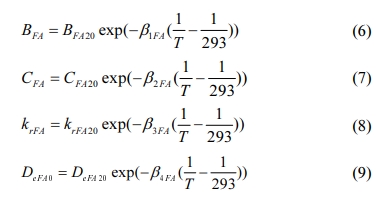
where BFA20,
CFA20, DeFA20, and krFA20
denote the values of coefficients BFA, CFA, DeFA0,
and krFA at 293 K, respectively; and b1FA, b2FA, b3FA,
and b4FA
denote the temperature sensitivity coefficients of BFA, CFA,
krFA0, and DeFA0,
respectively. Based on the reaction quantity of fly ash at various curing
temperatures, the temperature sensitivity coefficients b1FA, b2FA, b3FA,
and b4FA
can be discovered.
For binary composite, fly ash reaction and cement
hydration play a role in the hydration heat. The discharge of hydrate heat is
proportional to the amount of hydration. The entire hydration heat is the sum
of the reaction of fly ash and the hydration of cement. The hydration heat of
binary composite can be established as follows:

where Q is rate of heat
generation; HC and HFA denote of heat generation for cement and fly
ash, respectively, where HC can be determined from cement
compound compositions and HFA is equal to 50 kcal/kg [19]; and P * HFA * aFA
and C * HC * a
denote the release of heat from the reaction of fly ash and from the hydration
of cement, respectively.
The
strength development model
Compressive strength can be a basic property of
cement-based materials. The construction process and structural design closely
relate to the development of concrete strength. The strength of concrete is
linearly based on the reaction quantity of cement [20]. Con- sidering both the pozzolanic property of
fly ash and the hydration process of cement, the development of the strength of
binary composite can be discovered by:

where fc refers to the concrete strength; A1, A2, and A3 are the coefficients of strength; A*((C*a)/W) considers the influence of cement hydration on
strength; A2*((P*aFA)/W) considers the influence of fly ash hydration on
strength; and A3 considers the concrete strength starts after a threshold time, not after
the mixing time. The coefficients A1, A2, and A3 can be determined according to experimental outcomes of the strength of
concrete. Because the reaction amounts of binders a
and aFA
are dependent on time, the strength of concrete is a function
of time.
The
hydration heat model
As proven in eq. (10), the discharge of the hydration heat
of binary composite pertains to both cement and fly ash. To look for the
reaction coefficient of fly ash, we conducted experiments on isothermal
hydration heat with elevated temperatures and fly ash contents. The
water-to-binder ratio of the paste specimen was 0.5; the fly ash substitute
ratio was 0%, 20%, or 40%; and the temperatures were set as 20, 35, or 50 oC.
The chemical compositions of fly ash and cement are given in Table 1. The paste
was mixed utilizing a mechanical agitator and 5 g of paste was taken for the
measurement of hydration heat.
The development of hydration heat was measured by using TAM-air, and the
duration of the hydration heat measurement was 72 h [21, 22].
The experimental outcomes of the rate of hydration heat
are shown in Fig. 1. First, Fig. 1(a) shows for plain paste at 20 oC,
the main exothermic peak occurs at about 10 h. This exothermic peak is due to
the hydration of alite. At the deceleration stage, the exothermic peak may be
from the renewed dissolution of C3A [21, 22]. As the temperature
increases from 20 oC to 50 oC (from Fig. 1(a)
to 1(c)), the main exothermic peak occurs much earlier, and the value of the
exothermic peak also increases. Second, for binary composite, with increasing
contents of fly ash, the hydration heat decreases. This is from the dilution effect
of the addition of fly ash. In addition, for specimens with fly
ash, the occurrence time of the exothermic peak slightly retards. This can be
due to the fact that the reactivity of fly ash is gloomier than cement, and the
hydration heat of binary composite is lower than plain cement. Third, Fig. 1(c)
shows at 50 oC, for Portland cement, the exothermic peaks of C3S
reaction and C3A renewed dissolution merge together.
Meanwhile, for binary composite, at the deceleration stage, the
exothermic peak may be from the reaction of fly ash.
The reactivity of fly ash is low at normal temperatures, such as 20 oC,
and also the growing temperature can accelerate the reaction of fly ash and can
increase of heat release of binary composites [21, 22]. However, we ought to
observe that the hydration heat is not the direct measurement of the reaction
amount of fly ash. To calculate the reaction amount of fly ash, the regression
of the reaction coefficients of the blended hydration model is essential.
Within this study, experimental outcomes of cumulative hydration heat can be used for regression
of the coefficients of the blended hydration model.
As proven in eq. (10), hydration heat pertains to fly ash
reaction and cement hydration. The hydration heat of cement can be calculated
using the Portland cement hydration model within our previous
study [15, 21]. Furthermore, the coefficients of fly ash can be established
according to the experimental outcomes of the binary composite. The reaction
coefficients of fly ash are shown in Table 2. When the mixtures of concrete change,
the reaction coefficients do not change.
The calculation results of cumulative hydration heat are
shown in Fig. 2. Fig. 2(a) to 2(c) show in the early age, the accumulative
hydration heat rapidly increases, and at late ages, the increase in hydration
heat is not obvious, especially for specimens with a high
temperature of 50 oC. This is
because at the late age, diffusion is the control stage, and the hydration
of the binder is accelerated at elevated temperatures. Generally, the evaluation results show agreement with the experimental outcomes. From Fig. 2(a) to 2(c),
with an increasing fly ash substitution ratio, the cumulative hydration heat
becomes lower. This is because the reaction heat per mass and reactivity of fly
ash are less than that of cement.
Fig. 3 shows the reaction amount of cement and fly ash.
As proven in Fig. 3(a), given a particular temperature, the
hydration amount of cement in binary composite is greater than that in plain
cement. This is because of the dilution aftereffect of fly ash; after the
inclusion of fly ash, the water-to-cement ratio increases, and the rate of
hydration of cement increases correspondingly. As proven in
Fig. 3(b), using the growing fly ash substitute ratio, the
activation aftereffect of calcium hydroxide becomes weaker, and also the
reaction amount of fly ash decreases [23]. The reaction amount of fly ash is a
lot less than cement. Especially at 20 oC, the reaction amount
of fly ash is under 5%. At elevated temperatures, the
reaction amount of fly ash clearly increases [24]. Quite simply, isothermal
calorimetry with high tem peratures may be used for indirectly identifying the reaction amount of
fly ash.
Within this study, the reaction amount of fly ash was
determined using hydration heat. However, there are more experimental means of
measuring the reaction amount of fly ash, for example, the method of selective
dissolution or image analysis. Lam et al. determined the reaction amount of fly
ash using the selective dissolution method [3], in which the water-to-binder
ratio varied from 0.19 to 0.50, the fly ash substitute ratio varied from 0.25
to 0.55, and the testing ages varied from 7 days to 3 months. The
curing temperature of the paste specimen was 27 oC
[3].
According to the blended hydration model, the reaction
amount of fly ash was calculated. As proven in Fig. 4(a) to
4(d), given a particular water-to-binder ratio, the
reaction amount of fly ash decreases as fly ash-to-binder ratio increases [25].
This trend is comparable with that in Fig. 3(b). Additionally,
given a particular fly ash content, the reaction amount of
fly ash decreases as the water-to-binder ratio decreases. This is because the accessible
deposit space for hydration products becomes inadequate
for concrete that has a low water-to-binder ratio [26].
Fig. 4(e) shows that analysis outcomes generally accept
experimental outcomes. The correlation coefficients between the analysis outcomes and
the experimental answers are
0.97. Summarily, the suggested blended hydration model is applicable for a
number of ages, for example, early-age hydration (isothermal hydration heat)
and lengthy-term hydration (reaction amount at 3 months), and it is valid for
concrete with assorted water-to-binder ratio and fly ash contents. Since the
interactions between the hydration procedure for cement and the reaction
procedure for fly ash are taken into consideration with the items in capillary
water and calcium hydroxide, the coefficients of the binary composite hydration
model do not change for a number of mixtures.
Fig. 5 shows the dilution aftereffect of the addition of
fly ash. Given the same fly ash substitute ratio, for examples with low
water-to-binder ratio, the advance in the water-to-cement ratio is a lot more
significant than that with high water-to-binder ratio. First, Fig. 5(a) shows
for a paste that has a high water-to-binder ratio 0.5, the dilution effect is
not significant; thus, the advance in the hydration amount of cement is not
apparent. In addition, the water-to -binder ratios of Fig. 5(b) and 5c are 0.30
and 0.24, respectively. Compared with Fig. 5(a), the dilution effect shown in
Fig. 5(b) and Fig. 5(c) is more obvious. This is due to the reduction of
water-to-binder ratio from Fig. 5(a) to Fig. 5(b) and Fig. 5(c). Second, Fig.
5(d) shows for a paste that has a much lower water-to-binder ratio 0.19,
because of the dilution aftereffect of the addition of fly ash, the advance in
the hydration amount of cement is more apparent than Fig. 5(a), Fig. 5(b), and
Fig. 5(c).
The
strength progress model
As shown in eq. (11), the reaction amounts of binders can
be used for evaluating the strength progress of concrete. Lam et al. measured
the strength progress of binary composite paste [3]. The
mixture of paste specimens for the strength test was the same as those for the
reaction degree test. According to the experimental
outcomes of strength, the strength coefficients A1, A2, and A3
of eq. (11) were determined as 57.4, 123.1, and -36.2, respectively. The
strength coefficient of fly ash A2 was much higher than coefficient of cement A1.
This is because the SiO2 content of fly ash is a lot greater than
that of cement.
Fig. 6 shows the strength development. First, Fig. 6(a)
shows for paste that has a low water-to-binder ratio 0.19, in the early age,
the strength of the binary composite paste is gloomier than that of plain
paste. Meanwhile, at a late age, because of the evolution of pozzolanic
reaction, the strength of the blended paste can exceed
the plain paste [27]. As the fly ash-to-binder ratio increases, the time akin
to strength crossover retards [1]. This is because the reaction
amount of fly ash decreases as the fly ash-to-binder ratio increases (shown in
Fig. 4). Second, from Fig. 6(a-d), as the water-to-binder ratio increases, the
time akin to strength crossover retards. This is because the dilution effect is
a lot more apparent for concrete that has a low water-to-binder ratio [28].
Third, as the fly ash-to-binder ratio and water-to-binder ratio increase, the
intercept of the strength curve on the x axis increases. This trend of
intercepts is comparable to the trends of the final setting of concrete, which
increase when water-to-binder ratio or fly ash-to-binder ratio increases [29,
30]. Fourth, Fig. 6(e) shows that analysis outcomes generally
accept experimental outcomes. The correlation coefficients
between the analysis results and the experimental answers are 0.95. Summarily, the
suggested strength development model is applicable for ordinary-strength
(water-to-binder ratio 0.5), high-strength (water-to-binder ratio 0.3), and
ultra-high-strength (water-to-binder ratio 0.24 and 0.19) concrete that
contains various fly ash contents (0%–55%).
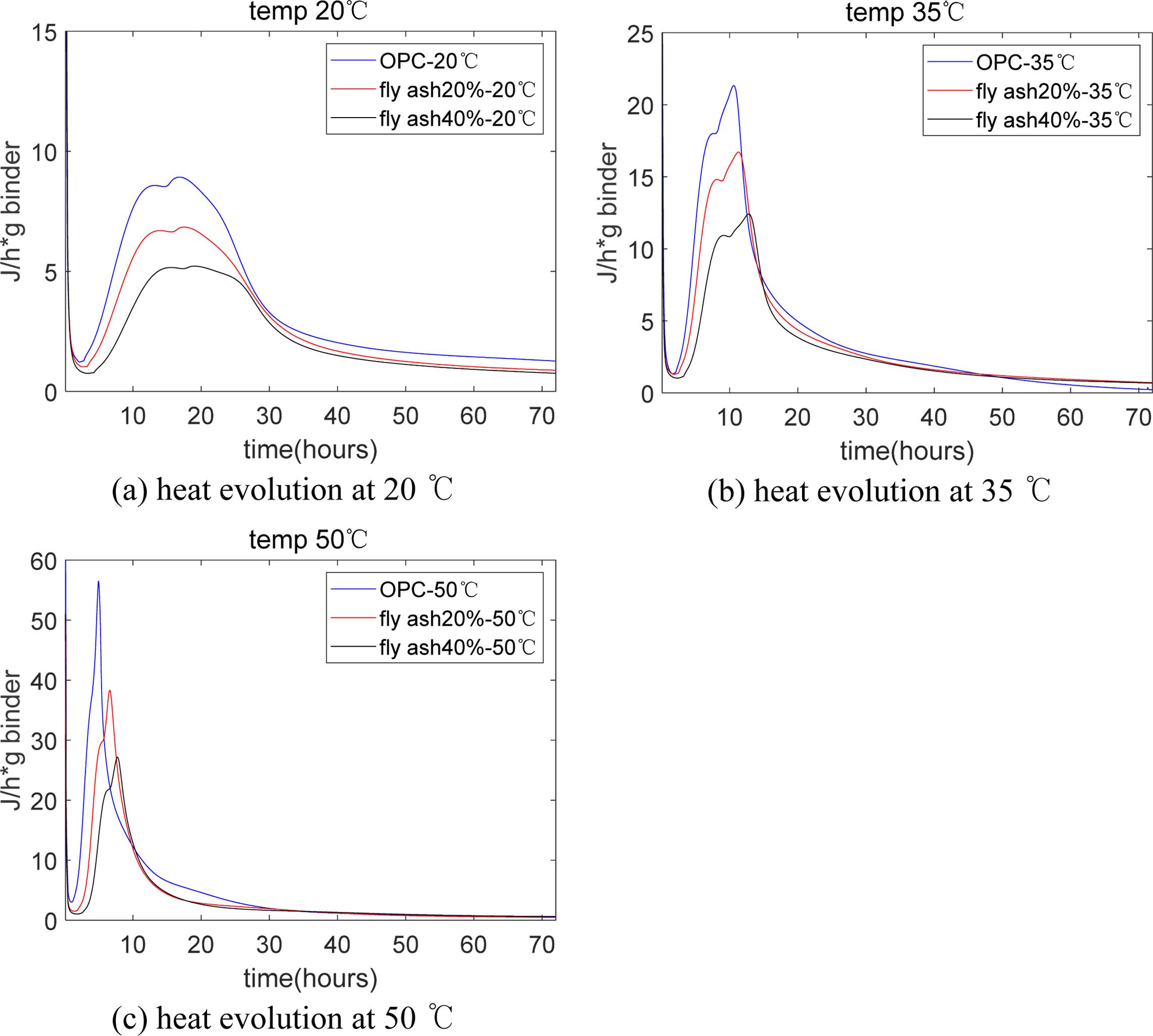
|
Fig. 1 Experimental results of the rate of heat evolution. |
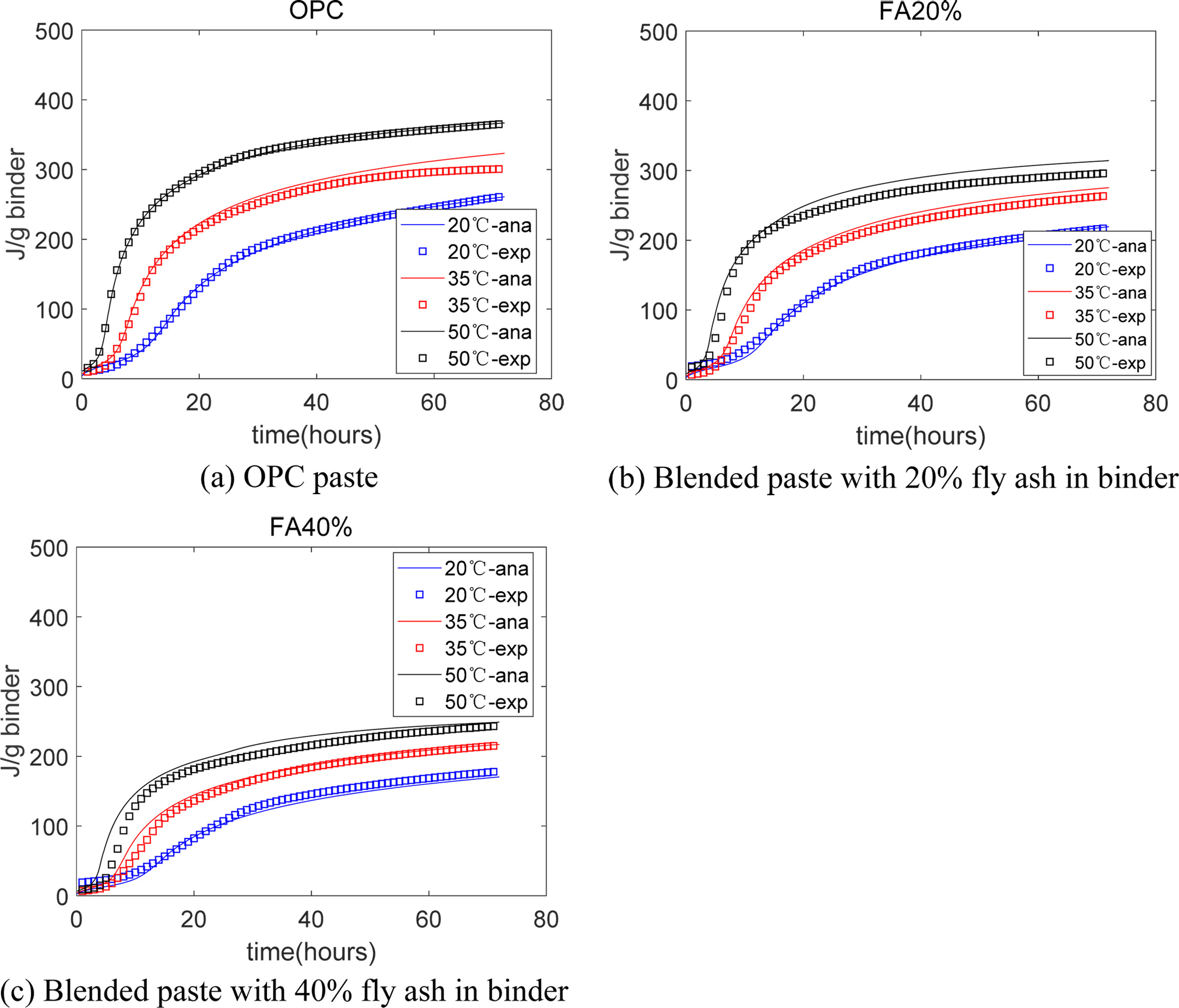
|
Fig. 2 Evaluation results of cumulative heat. |
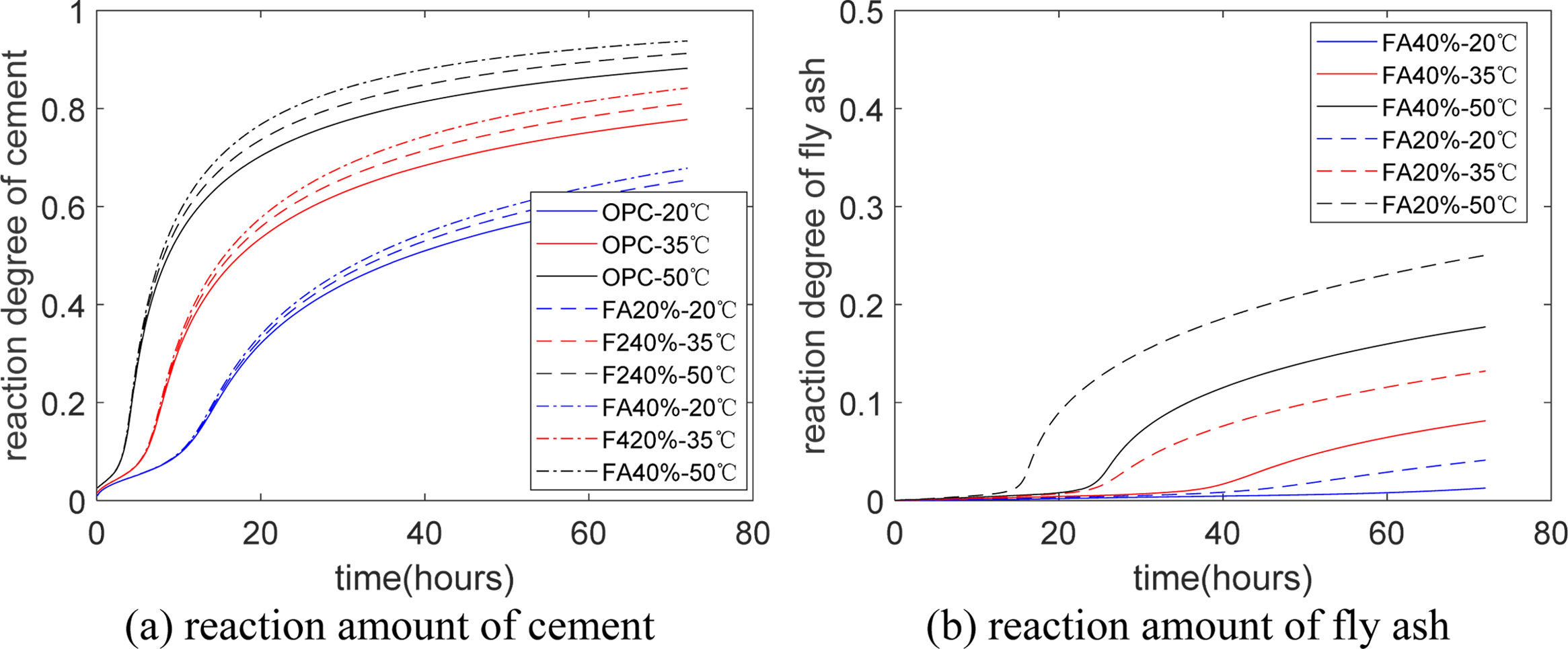
|
Fig. 3 The reaction amount of binders. |
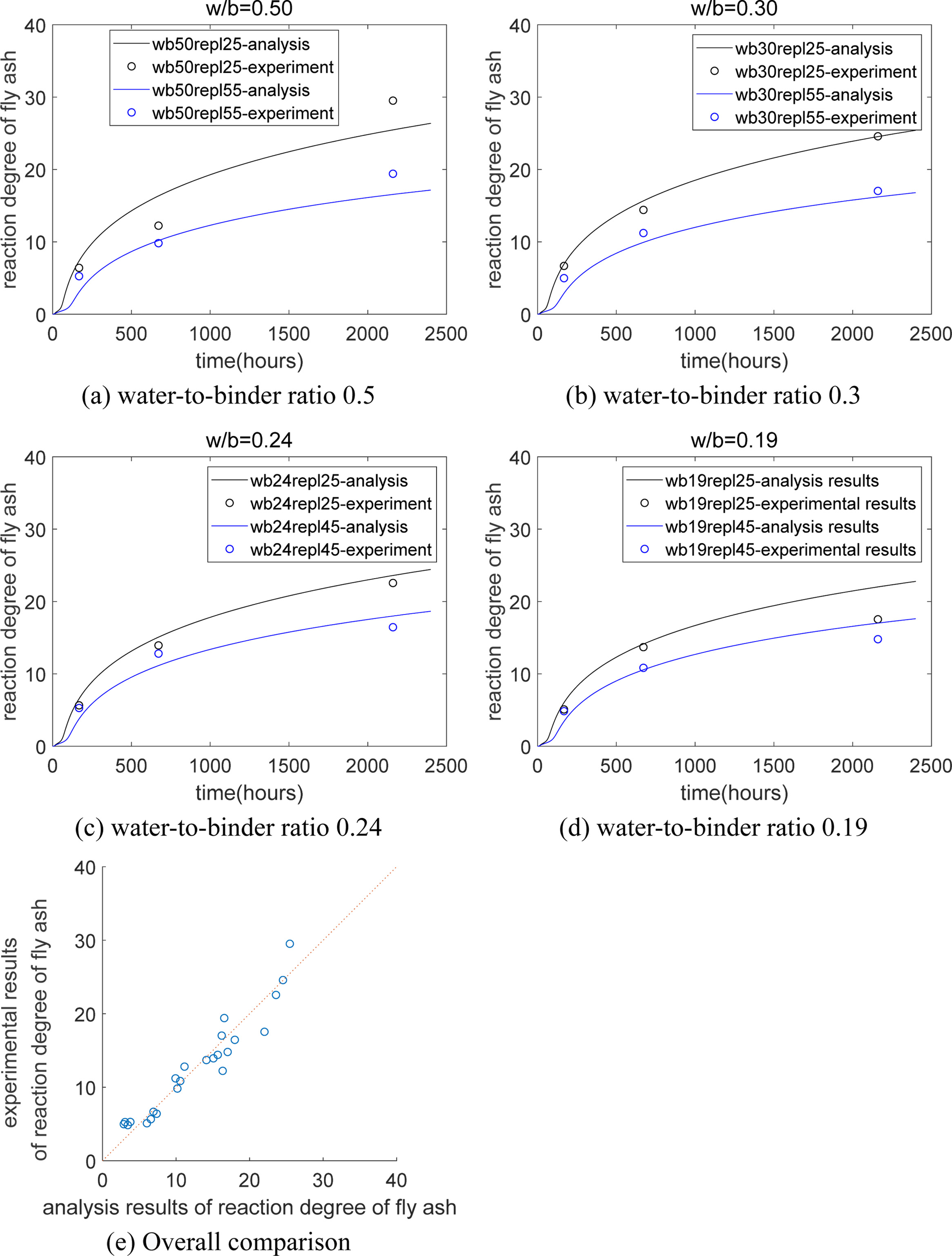
|
Fig. 4 Verifications of the reaction amount of fly ash. |
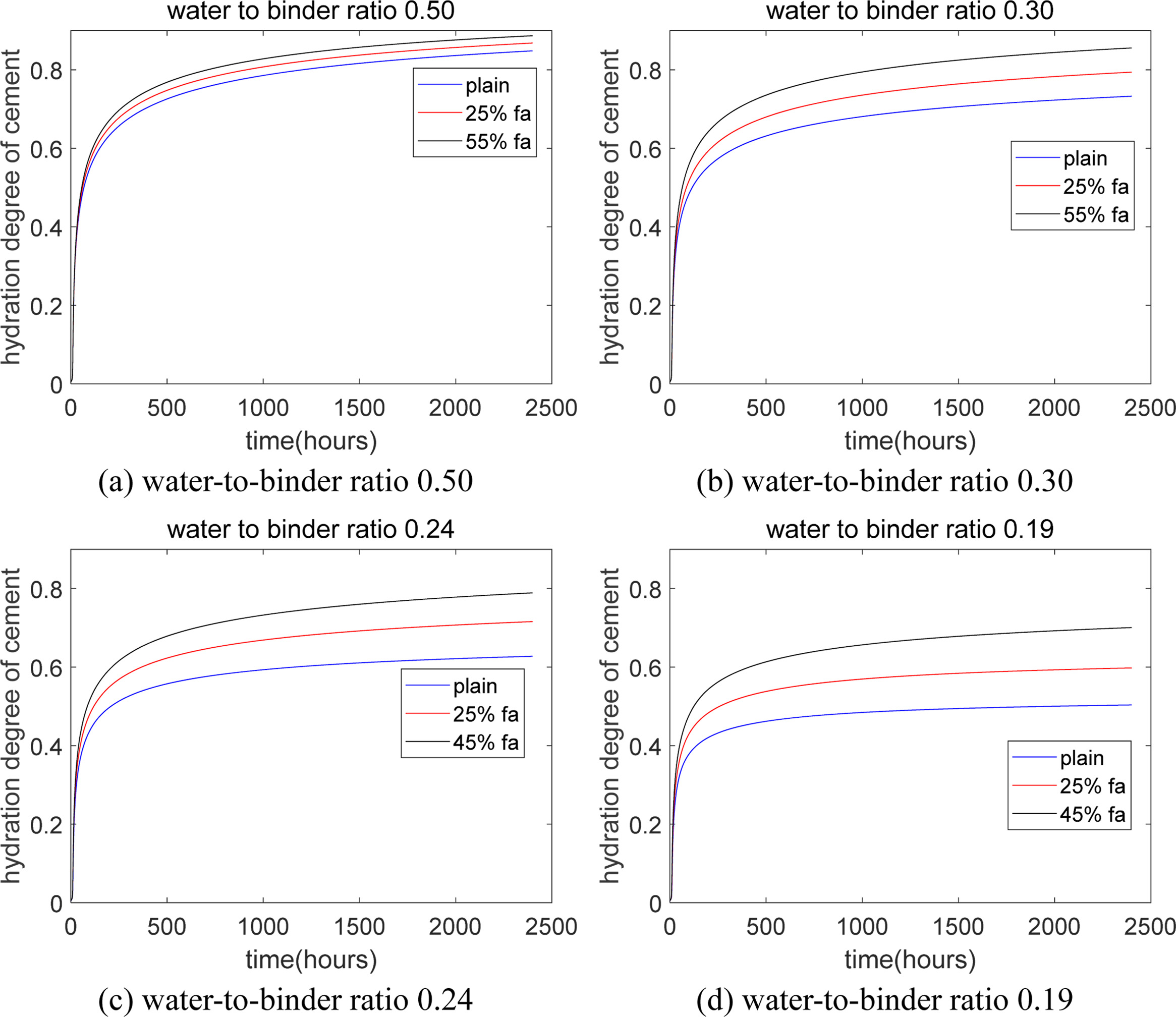
|
Fig. 5 Dilution effect of fly ash addition. |
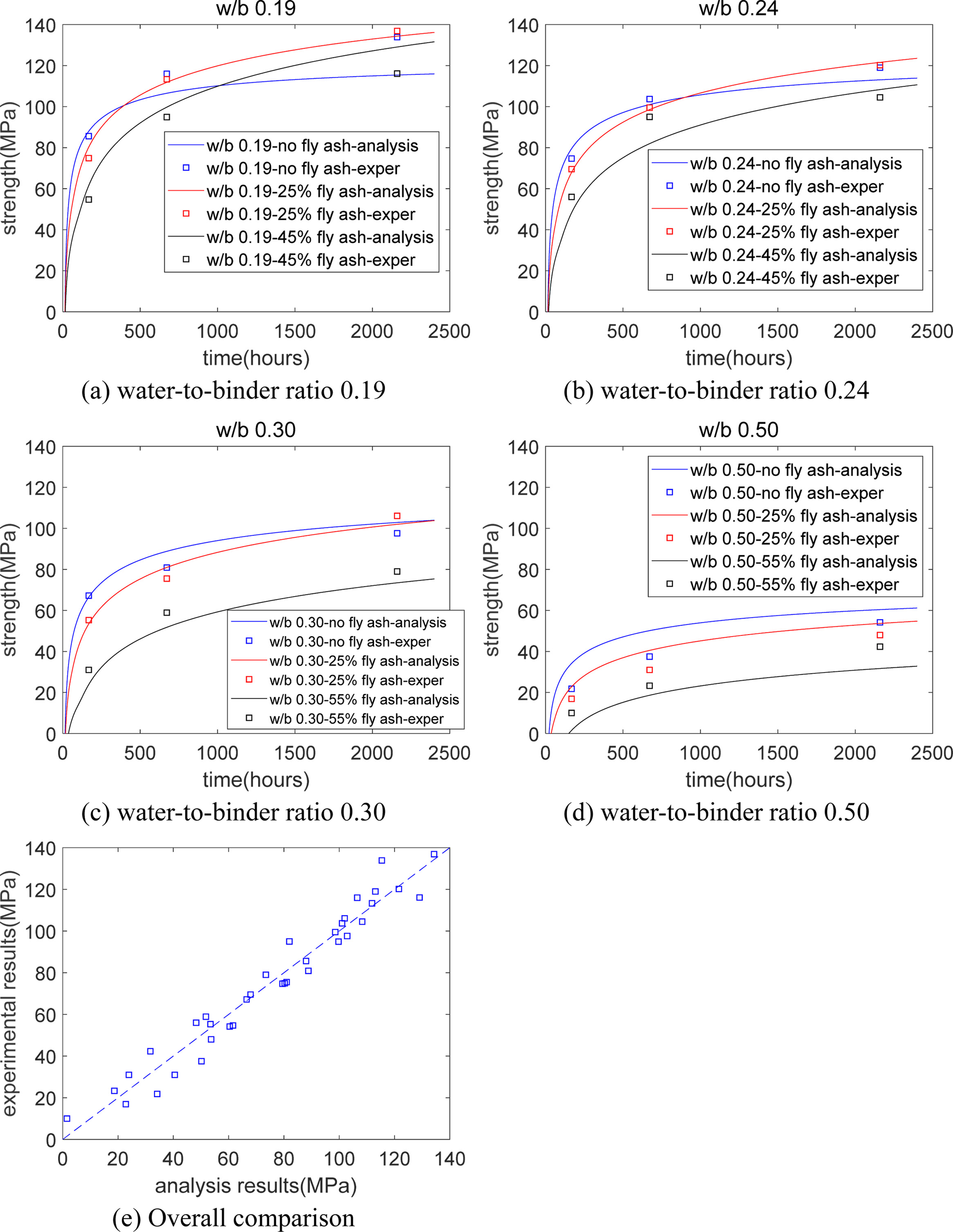
|
Fig. 6 The strength progress of binary composite paste |
This research presented a framework for evaluating the
hydration heat, reaction amount, and strength progress of cement–fly ash binary
composite.
First, isothermal calorimetry testing with high tem- peratures was used to indirectly
identify the reaction amount of fly ash. According to the experimental outcomes
of cumulative hydration heat at various temperatures, by using the hydration
heat model considering the contribution of fly ash and cement, the reaction
coefficients of a kinetic reaction model of fly ash were determined.
Second, the reaction amount of binders was calculated
using the composite reaction model. We discovered that the hydration amount of
cement in composite binder is greater than that in plain cement, the reaction
amount of fly ash is significantly improved at elevated temperatures, and also
the reaction amount of fly ash decreases as the contents of fly ash increase.
The suggested blended hydration model is applicable for various mixtures at
both early and late ages.
Third, in line with the reaction amount of fly ash and
cement, we proposed a straight-line equation for evaluating the strength
progress of binary composite. The results of the analysis can reflect the
crossover of the strength progress of fly ash composite concrete. As the
content of fly ash and the water-to-binder ratio increase, the threshold time
of strength development increases, and the time akin to strength crossover
retards. The dilution effect is apparent for concrete that has a low water to
binder ratio.
Fourth, the suggested model is applicable for ordinary-strength,
high-strength, and ultra-high-strength concrete with assorted fly
ash contents and water-to-binder ratios. The coefficients of hydration model,
heat model and strength model are constants for a number of mixtures. The
suggested hydration heat-strength progress model is helpful for material style
of concrete that contains fly ash.
This research was supported by the Basic Science Research
Program through the National Research Foundation of Korea (NRF), funded by the
Ministry of Science, ICT & Future Planning (No.
2015R1A5A1037 548), and an NRF grant
(NRF-2020R1A2C4002093).
- 1. C.S. Poon, L. Lam, and Y.L. Wong, Cement. Concrete Res. 30 (2000) 447-455.
-

- 2. W. Wongkeo, P. Thongsanitgarn, A. Ngamjarurojana, and A. Chaipanich, Mater. Design. 64 (2014) 261-269.
-

- 3. L. Lam, Y.L. Wong, and C.S. Poon, Cement. Concrete Res. 30 (2000) 747-756.
-

- 4. A.K. Schindler and K.J. Folliard, Aci. Mater. J. 102 (2005) 24-35.
- 5. I. Pane and W. Hansen, Cement. Concrete Res. 35 (2005) 1155-1164.
-

- 6. F. Han, Z. Zhang, J. Liu, and P. Yan, J. Therm. Anal. Calorim. 124 (2016) 1691-1703.
-

- 7. G. Baert, N.D. Belie, and G.D. Schutter, J. Mater. Civil. Eng. 23 (2011) 761-766.
-

- 8. S.K. Nath, S. Mukherjee, S. Maitra, and S. Kumar, J. Therm. Anal. Calorim. 127 (2017) 1953-1961.
-

- 9. F. Deschner, B. Lothenbach, F. Winnefeld, and J. Neubauer, Cement. Concrete Res. 52 (2013) 169-181.
-

- 10. Q. Xu, J. Hu, J.M. Ruiz, K. Wang, and Z. Ge, Thermochim. Acta 499 (2010) 91-99.
-

- 11. M. Narmluk and T. Nawa, Cement. Concrete Res. 41 (2011) 579-589.
-

- 12. I. Garcia-Lodeiro, S. Donatello, A. Fernández-Jiménez, and Á. Palomo, Materials 9 (2016) 604-620.
-

- 13. X.-Y. Wang, Constr. Build. Mater. 64 (2014) 1-10.
-

- 14. W. Huang, H. Kazemi-Kamy, W. Sun, and K. Scrivener, Cement. Concrete Comp. 77 (2017) 86-101.
-

- 15. X.-Y. Wang and K.-B. Park, Cement. Concrete Res. 102 (2017) 1-15.
-

- 16. V.G. Papadakis, Cement. Concrete Res. 30 (2000) 291-299.
-

- 17. T. Hemalatha and A. Ramaswamy, J. Clean. Prod. 147 (2017) 546-559.
-

- 18. F. Moghaddam, V. Sirivivatnanon, and K. Vessalas, Case Studies in Construction Materials 10 (2019) e00218.
-

- 19. K. Maekawa, T. Ishida, and T. Kishi, in “Multi-Scale Modeling of Structural Concrete” (Taylor & Francis, 2009) p.72-74.
-

- 20. V.G. Papadakis, Adv. Concr. Constr. 1 (2013) 201-213.
-

- 21. X.-Y. Wang, Materials 10[2] (2017) 115-130.
-

- 22. R.-S. Lin, X.-Y. Wang, H.-S. Lee, and H.-K. Cho, Materials 12 (2019) 458-478.
-

- 23. Q. Zeng, K. Li, T. Fen-chong, and P. Dangla, Constr. Build. Mater. 27 (2012) 560-569.
-

- 24. X. Gao, Q.L.Yu, and H.J.H.Brouwers, Constr. Build. Mater. 80 (2015) 105-115.
-

- 25. A. Wang, C. Zhang, and W. Sun, Cement. Concrete Res. 34 (2004) 2057-2060.
-

- 26. H. Ma, B. Xu, and Z. Li, Cement. Concrete Res. 65 (2014) 96-104.
-

- 27. G. Hannesson, K. Kuder, R. Shogren, and D. Lehman, Constr. Build. Mater. 30 (2012) 161-168.
-

- 28. Y. Luan, T. Ishida, T. Nawa, and T. Sagawa, J. Adv. Concr. Technol. 10 (2012) 1-13.
-

- 29. J. Hu, Z. Ge and K. Wang, Constr. Build. Mater.50 (2014) 657-663.
-

- 30. D.P. Bentz and C.F.Ferrari, Cem. Concr. Compos. 32 (2010) 265-270.
-

 This Article
This Article
-
2020; 21(6): 622-631
Published on Dec 31, 2020
- 10.36410/jcpr.2020.21.6.622
- Received on Mar 24, 2020
- Revised on Jun 15, 2020
- Accepted on Jul 16, 2020
 Services
Services
- Abstract
introduction
the hydration and strength development models
verifications of the hydration heat and strength progress model
conclusions
- Acknowledgements
- References
- Full Text PDF
Shared
 Correspondence to
Correspondence to
- Xiao-Yong Wang
-
aDepartment of Architectural Engineering, Kangwon National University, Chuncheon 24341, Korea
bDepartment of Integrated Energy and Infra System, Kangwon National University, Chuncheon 24341, Korea
Tel : +82332506229 Fax: +82332595542 - E-mail: wxbrave@kangwon.ac.kr






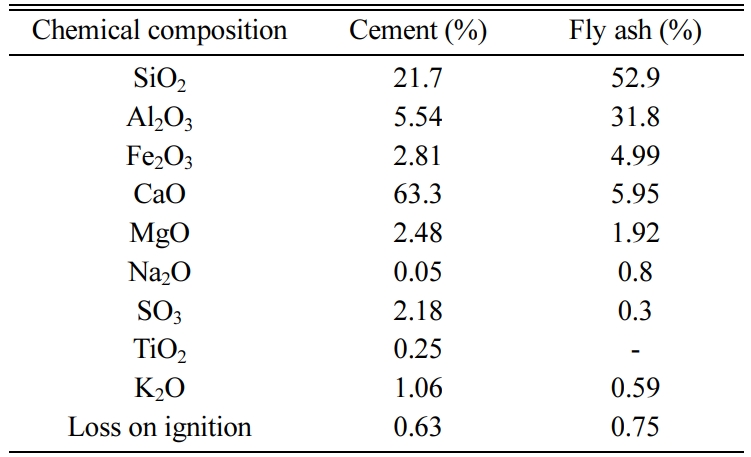

 Copyright 2019 International Orgranization for Ceramic Processing. All rights reserved.
Copyright 2019 International Orgranization for Ceramic Processing. All rights reserved.